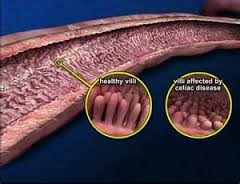At the 2015 Celiac Disease Foundation National Conference & Gluten Free EXPO, Joseph Murray, MD, a member of Celiac Disease Foundation’s Medical Advisory Board, and President of the North American Society for the Study of Celiac Disease (NASSCD), gave a presentation that outlined the biological, symptomatic, and epidemiological basics of celiac disease for conference attendees. He stressed that although the biology of the disease may be the same in everyone, the time and presentation of symptoms may vary.
 Dr. Murray opened with a case study which displayed one presentation of celiac disease. He then continued to explain more about the normal composition of the gut and intestines, and was able to show the difference between healthy villi and flattened or damaged villi present in those with untreated celiac disease. He concluded this segment with the basic definition of the disease as an inflammatory state of the small intestine, and quickly mentioned celiac disease’s origins and discovery in the 1950s.
Dr. Murray opened with a case study which displayed one presentation of celiac disease. He then continued to explain more about the normal composition of the gut and intestines, and was able to show the difference between healthy villi and flattened or damaged villi present in those with untreated celiac disease. He concluded this segment with the basic definition of the disease as an inflammatory state of the small intestine, and quickly mentioned celiac disease’s origins and discovery in the 1950s.
Following this, Dr. Murray focused on symptoms. He made clear that not all are related to the gut, and presented some classical symptoms from stomach and gastrointestinal problems, to joint pain and memory problems. Iron deficiency, rashes, other skin problems, enamel defects, bone problems, and lastly, reproductive effects of the disease, were focused on in detail and later elaborated on by Sheila Crowe, MD.
Dr. Murray explained testing for celiac disease; he clarified for the audience the details of the genetic test for celiac disease, which can only rule out celiac disease, but cannot confirm a diagnosis. A strong positive result of the common serological test, the anti-tTG, means having a greater chance of having the disease. As Dr. Murray continued to enforce the idea that an endoscopy must be done and a biopsy must be taken to confirm the presence of celiac disease, he showed examples of endoscopy results so the audience could better understand anatomically how the damage can differ among individuals.
 Furthermore, Dr. Murray mentioned that onset can be sudden, and that celiac disease may not display itself until a person becomes much older. Information was also presented about the increasing rate of the disease. Dr. Murray was sure to note this is not just due to higher diagnostic rates, and added that current statistics show that only one out of five are properly diagnosed. In other words, 83% of the population with celiac disease has yet to be diagnosed and are needlessly suffering. Dr. Murray made clear that the disease is changing over time, and that though in some cases is less severe (which may also be leading to the problem of misdiagnosis), it is becoming more common.
Furthermore, Dr. Murray mentioned that onset can be sudden, and that celiac disease may not display itself until a person becomes much older. Information was also presented about the increasing rate of the disease. Dr. Murray was sure to note this is not just due to higher diagnostic rates, and added that current statistics show that only one out of five are properly diagnosed. In other words, 83% of the population with celiac disease has yet to be diagnosed and are needlessly suffering. Dr. Murray made clear that the disease is changing over time, and that though in some cases is less severe (which may also be leading to the problem of misdiagnosis), it is becoming more common.
So how is research moving forward? Dr. Murray explained that the medical community is working toward a less invasive means of diagnosis and more accurate testing. “Right now, the gluten-free diet is the only way to effectively manage celiac disease,” Dr. Murray says. But the question remains – will people with celiac disease or gluten sensitivity ever be able to eat gluten again? Celiac disease should not be burdensome, and Dr. Murray’s primary goal is to make sure it is not such a heavy burden as it is now.